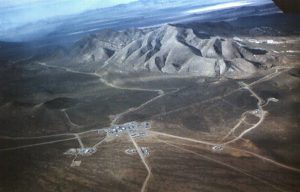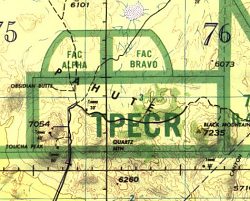
Tolicha Peak Electronic Combat Range (TPECR)
 Tolicha Peak Electronic Combat Range (TPECR) |
Main access to the facility is via a paved road from Highway 95. The intersection of this access is about 20 miles north of the town of Beatty. There are no signs on the access, but after about 2 miles a guard house is reached, blocking further travel.
The only known ground viewpoint is about 18 miles away to the north, from any of a number of spots in the Stonewall Peak area. Of course, another alternative is from the air, since this facility is beneath a portion of airspace whose restriction was eased in July of 1995 to allow civilian overflights on weekends. A Sunday morning overflight is a distinct possibility and is something I have since done.
The view from the Stonewall Peak area reveals this to be an installation of considerable size, spread out over several square miles. The facilities are located out on Pahute Mesa and on the alluvial fans out away from the surrounding mountains. The main complex has a number of structures, including what appear to be 2 hangars, but they may also be warehouse or workshop structures. There were no obvious signs of a landing strip. To the north of the main complex, there was another interesting installation with some sort of long antenna array, laid out in an east/west direction. There were several other outlying facilities, consisting of at least a few sizable buildings each.
 Portion of range chart showing TPECR |
Presumably from the name, the facility is involved in electronic combat operations involving aircraft. Some Tonopah Test Range documents refer to a "Tonopah Electronic Combat Range". The Tonopah Electronic Combat Range is located on the east side of TTR quite a few miles from TPECR.
It is uncertain just how long this facility has been in operation. A review of the Landsat "Pahute Mesa" 1:100,000 image, published by the USGS in 1984, suggests if the facility was there at that time, it was considerably smaller, although the limited resolution of the image makes positive identification difficult. If the facility is one that has either been built or greatly expanded in recent years, it may be the source of the stories, most often put forth by John Lear, that the alleged discs of Papoose Lake have been moved to Pahute Mesa. Thus a perfectly mundane, although secret, facility could have generated some pretty outlandish stories.
Since I've placed some of this info on the web, I have received bits of additional data from individuals who worked at TPECR or were familiar with it. The following is a particularly good rendition, from someone who prefers anonymity:
I have no current knowledge of Tolicha Peak/Pahute Mesa facilities, but I did work there, and at the Tonopah Electronic Combat Range, in the mid 70's - early 80's. At that time, as you indicated, all that was there was the Tolicha Peak Electronic Combat Range.End quote.To my extensive but dated, knowledge, Sandia does not have any facilities at Tolicha Peak. They do, as you know, have a facility at the Tonopah Test Range. From my knowledge (limited) of Sandia's mission I doubt that they would have much interest in the TPECR area. However, due to the physical proximity they might have a small support operation of some kind there. I don't find this very likely unless their mission has changed, as they had no interest during the period that I worked there.
I don't recall the exact date that operations began at Tolicha Peak but there was a small operation there in the mid 70's. At that time it operated as a satellite operation of the Tonopah ECR. As more money and equipment became available it grew to a rather large operation.
It (and other Electronic Combat Ranges including the Tonopah Electronic Combat Range) was operated by the 554th Range Group at Nellis and later by Ford Aerospace as a contractor to the 554th. I understand that Ford lost/sold the contract, so someone else is now operating it.
Sandia's operations had no connection with the Tonopah Electronic Combat Range except for sharing the land and air space. They did provide some support to the TECR such as civil engineering, etc. TECR was essentially a lessee there. When I began work there most support facilities, i.e., buildings, belonged to Sandia. A few years later (roughly 1980) a new Operations and Maintenance Facility (site 4?) was built to the south and east of the Sandia compound. There was a helicopter pad there, and as I remember, some old (WW II?) bunkers. The presence of the bunkers was surely coincidental.
The Air Force started their electronic combat operations there in the early to mid 70's. The out growth of these operations is now known as Operation Red Flag and other such training exercises. The history of this training operation is pretty well documented in various books and other sources, even one bad movie that bore little resemblance to the real thing.
I think that a study of the 554th Range Group/Squadron, Operation Red Flag, and Nellis AFB in general, would provide explanations for many of the stories that surround Area 51 and other locations in the Nevada desert.
For example, the 554th built extensive targets throughout the area, including at least three airfields. They were made as realistic as possible within time and funding constraints, and the knowledge that they would be bombed, sometimes with live ordinance. Many looked very real from a distance especially from the air, as was intended. Salvaged vehicles, various portable shelters, plywood tanks, and even an occasional airplane were, and I presume still are, used to add realism to some relatively crude earth work.